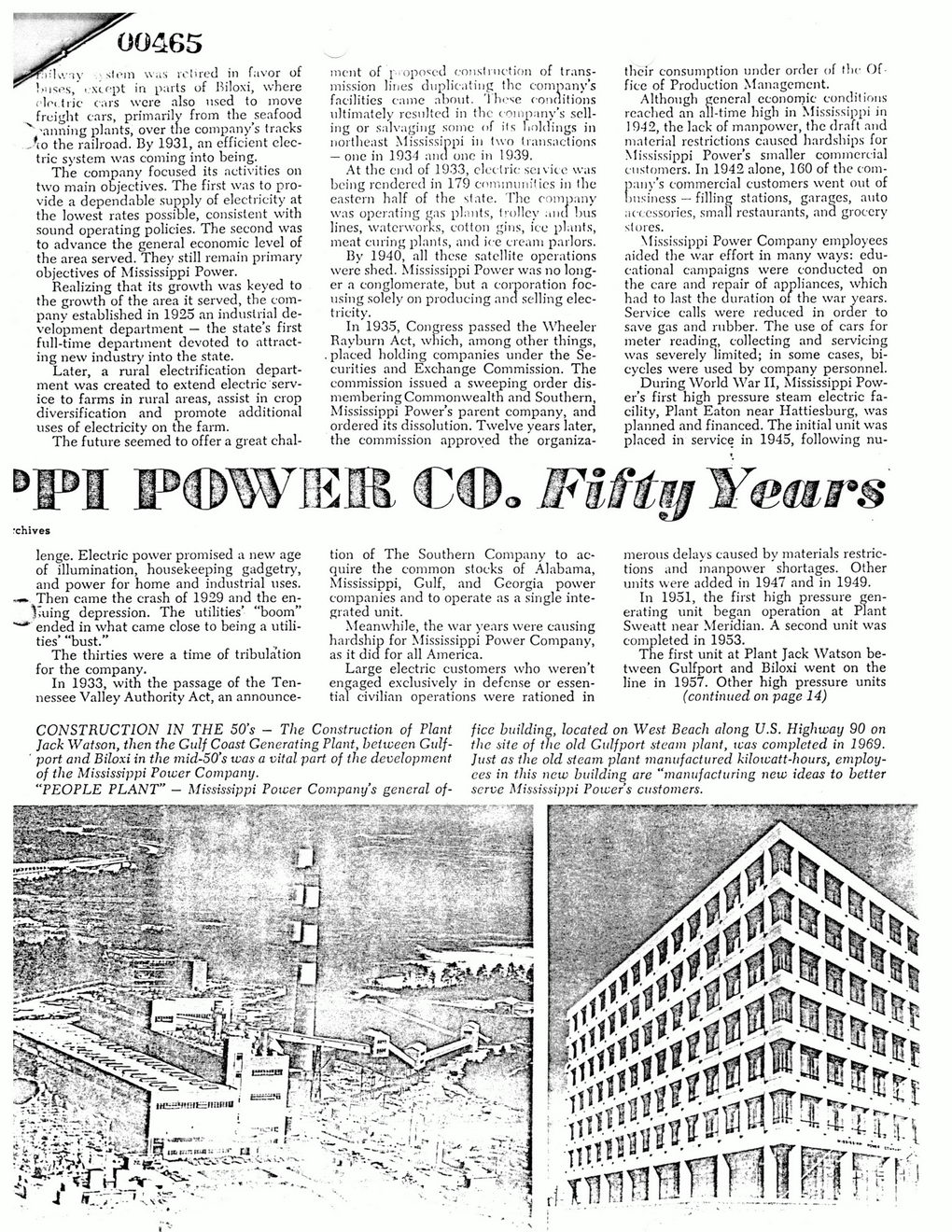This text was obtained via automated optical character recognition.
It has not been edited and may therefore contain several errors.
00465 stem was retired in favor of buses, i xcept in parts of Biloxi, where dec trie cars were also used to move freight cars, primarily from the seafood " 'aiming plants, over the company’s tracks Ao the railroad. By 1931, an efficient electric system was coming into being. The company focused its activities on two main objectives. The first was to provide a dependable supply of electricity at the lowest rates possible, consistent with sound operating policies. The second was to advance the general economic level of the area served. They still remain primary objectives of Mississippi Power. Realizing that its growth was keyed to the growth of the area it served, the company established in 1925 an industrial development department — the state’s first full-time department devoted to attracting new industry into the state. Later, a rural electrification department was created to extend electric service to farms in rural areas, assist in crop diversification and promote additional uses of electricity on the farm. The future seemed to offer a great chal- ment of [■ opened construction of transmission lines duplicating the company’s facilities came about. 'Ihese conditions ultimately resulted in the company’s selling or salvaging some of ils holdings in northeast Mississippi in two transactions — one in 193-4 and one in 1939. At the end of 1933, elect lit: seivice was being rendered in 179 communities in the eastern half of the state. The company was operating gas plants, trolley anil bus lines, waterworks, cotton gins, ice plants, meat curing plants, and ice cream parlors. By 1940, all these satellite operations were shed. Mississippi Power was no longer a conglomerate, but a corporation focusing solely on producing and selling electricity. In 1935, Congress passed the Wheeler Rayburn Act, which, among other things, .placed holding companies under the Securities and Exchange Commission. The commission issued a sweeping order dismembering Commonwealth and Southern, Mississippi Power’s parent company, and ordered its dissolution. Twelve years later, the commission approved the organiza- their consumption under order of the Of fice of Production Management. Although general economic conditions reached an all-time high in Mississippi in 1942, the lack of manpower, the draft and material restrictions caused hardships for Mississippi Power’s smaller commercial customers. In 1942 alone, 160 of the company’s commercial customers went out of business — filling stations, garages, auto accessories, small restaurants, and grocery stores. Mississippi Power Company employees aided the war effort in many ways: educational campaigns were conducted on the care and repair of appliances, which had to last the duration of the war years. Service calls were reduced in order to save gas and rubber. The use of cars for meter reading, collecting and servicing was severely limited; in some cases, bicycles were used by company personnel. During World War II, Mississippi Power’s first high pressure steam electric facility, Plant Eaton near Hattiesburg, was planned and financed. The initial unit was placed in service in 1945, following nu- ■chives lenge. Electric power promised a new age of illumination, housekeeping gadgetry, and power for home and industrial uses. Then came the crash of 1929 and the enduing depression. The utilities’ “boom” ended in what came close to being a utilities’ “bust.” The thirties were a time of tribulation for the company. In 1933, with the passage of the Tennessee Valley Authority Act, an announce- tion of The Southern Company to acquire the common stocks of Alabama, Mississippi, Gulf, and Georgia power companies and to operate as a single integrated unit. Meanwhile, the war years were causing hardship for Mississippi Power Company, as it did for all America. Large electric customers who weren’t engaged exclusively in defense or essential civilian operations were rationed in merous delays caused by materials restrictions and manpower shortages. Other units were added in 1947 and in 1949. In 1951, the first high pressure generating unit began operation at Plant Sweatt near Meridian. A second unit was completed in 1953. The first unit at Plant Jack Watson between Gulfport and Biloxi went on the line in 1957. Other high pressure units (continued, on page 14) CONSTRUCTION IN THE 50’s — The Construction of Plant ficc building, located on West Beach along U.S. Highway 90 on Jack Watson, then the Gulf Coast Generating Plant, between Gulf- the site of the old Gulfport steam plant, teas completed in 1969. port and Biloxi in the mid-50’s was a vital part of the development Just as the old steam plant manufactured kilowatt-hours, employ- of the Mississippi Power Company. Ces in this new building are “manufacturing new ideas to better “PEOPLE PLANT” — Mississippi Power Company’s general of- serve Mississippi Powers customers. sS!SSPEIi: S-i5£?w?_.__ E <s" ,1 IKir-HMIItilinlllO * 1 ‘ ' I.-1'* , * „ rr‘.i M ft* ftv

Coast General Mississippi-Power-Company-(1)